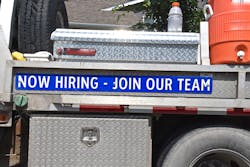George Karolidis didn’t go to college to become a project manager for the No. 15 Top 50 Electrical Contractor in EC&M’s 2021 rankings. In fact, he didn’t plan to go into the electrical contracting field at all. Nor did Russ Lancey plan to become an estimator – let alone go on to become president and CEO of the No. 18 contractor (Five Star Electric) on EC&M's list. But here they are. How they wound up in the electrical field, why they’ve stayed, and what they’ve learned along the way are worth pondering as the profession struggles to find enough skilled workers.
Karolidis was a junior studying electrical engineering at New York University, where E-J Electric Installation Co. had a booth at the school’s job fair. “It attracted my interest,” he says. “They worked on JFK Airport and some of the high rises in Manhattan, such as Bank of America Tower – these big-name projects. I was like, ‘Oh, wow! I want to be a part of that.’ I didn't even know what electrical construction was.”
E-J’s reps asked Karolidis whether he had any construction experience – he didn’t – and about his level of comfort with AutoCAD. “They gave me an internship from my grades and my attitude, and the rest is history,” he says.
Karolidis started as a junior estimator/assistant project manager (PM). Today, he’s a senior PM at Long Island City-based E-J, is running two projects, and was selected as one of EC&M’s “30 Under 30 All-Stars” for 2022.
Lancey took an even more serendipitous route. After graduating from the University of Rhode Island with a bachelor’s degree in electrical engineering, he went to work for the parent company of ABC Radio, ESPN, and Radio Disney. While serving as a broadcast engineer, he was asked to oversee a major remodel of the company’s studios in New York City.
“One of the electrical contractors that I ended up hiring offered me a job at the end of the renovation,” says Lancey, who was named president and CEO of Five Star Electric at age 34 in 2019. “I never thought I would end up in the construction world, but sometimes you can't plan your path. A lot of it is timing and opportunities that become available.”
Casting a wider net
These days, there are more opportunities than ever, thanks to some recent trends that also have increased the challenge of finding enough people to fill them.
“The emerging decarbonization/electrification trends have placed more emphasis/burden on the electrical engineering community as compared to other consultants,” says Robert Ioanna, Syska Hennessy Group CTO. “Also, as a result of the increased amount of remote working and cloud computing usage from the pandemic, the data center industry is at historic levels of design and construction. The complexity of these electrical designs has placed more burden on the electrical engineering community. This need is amplified on all sides of the table: owners, engineers, developers, owner’s reps, facilities, CMs.”
EC&M surveyed hundreds of electrical engineering and contracting firms in its annual Top 40 and Top 50 surveys to find out which positions have the highest demand and how firms are finding candidates.
“Supervising engineer and senior engineer are two positions we have the most difficulty filling,” says Ann Bonney, HR director at Long Beach, Calif.-based P2S. “We are not receiving applications from this level of employee and have to source passive candidates on LinkedIn, Indeed, or through employee referrals. Traditionally, the more experienced engineer positions have been challenging to fill, but the market has become more competitive with more job openings than qualified candidates.”
Like many of its peers, P2S has changed its recruitment strategy.
“We have significantly increased our social media advertising on LinkedIn and Indeed in 2022,” Bonney says. “We actively used LinkedIn Recruiter to source candidates passively but now have unlimited job posting slots, automated job wrapping from our ATS, and a premium career page for increased candidate impressions. We currently sponsor P2S jobs on Indeed to stay on the first pages of search results, a P2S Logo on postings, and a career page. Since adding these features, we have experienced increased applications, with most candidates entry to mid-level engineers.”
Other firms are stepping up their use of traditional media such as radio. For example, in the past year, Jacksonville, Fla.-based Miller Electric began advertising on three stations whose widely different formats — country, easy listening, and sports — help reach a variety of demographics.
“Sometimes it's just general, like ‘We're hiring, and here are our pay rates,’” says Maggie Lorenz, marketing communications specialist. “Every few months or so, we have job fairs at our Jacksonville offices. So then we'll [switch] the radio ads to ‘Are you looking for a new career?’ or ‘Do you have a lot of experience?’ Right now, we're trying to focus on experienced workers. We're trying to really tailor those radio ads and social media ads to people who have years of experience: the journeymen. We have a pretty robust radio campaign, but we're looking to bump it up even more.”
Those commercials also caught the attention of national outlets such as Cox Media Group and iHeartMedia.
“They want to offer us a comprehensive radio, digital, all-inclusive campaign,” Lorenz says. “We're kind of deciding where we want to go with that. We're potentially looking to invest a big chunk of money with a big name that would handle all of our recruitment needs.”
Sparking interest
Many contractors and design firms also are increasing their efforts to make young people — and their parents — aware of the lucrative career opportunities.
“There is definitely a stigma around the idea of attending a four-year university and getting a bachelor’s degree being the standard of future success,” says Taylor Groves, project manager at Knoxville-based Stansell Electric and one of EC&M’s “30 Under 30 All-Stars” for 2022. “That is simply not true. Not only are jobs in the trades at an extremely high demand, but they are very fulfilling. I always wanted to have a set of skills that no one could take away from me or easily recreate.”
The profession also benefits when younger employees share that sense of fulfillment with people their age, as Karolidis has done with his former electrical engineering classmates.
“It's something that surprises them,” Karolidis says. “It's something that intrigues them. They think, ‘Maybe I should consider that as a career option, too.’
“When I told them I went into construction, they said, ‘You went to school for four years to wear boots?’ And I'm like, ‘It's not that cut and dry.’ It's much more than that. We actually take a lot of the basic foundation that you learn in engineering to solve real-life problems. I still keep in touch with some of my classmates, and I have to say I think I'm happier than they are today.”
Apprenticeships are more important than ever when it comes to attracting young people.
“I went through the apprenticeship, and most of the people on my team also went through an apprenticeship, so we see the value in that,” says Jeff Daigle, workforce development training manager at San Jose, Calif.-based Rosendin Electric. “Anybody that we're in contact with that, [we say] the best avenue is to go through the apprenticeship.”
Miller Electric participated in more than 140 school events so far this year, showcasing opportunities such as its Electrical Training Alliance apprenticeship program. Seven high school students can take pre-apprenticeship classes to get a head start on their careers.
“It turns a five-year program into a four-year program and gives them a vested interest in us, so they don't get out of school and go to work in some other trade or some other industry,” says Tim Hinson, Miller Electric director of workforce development. “They can finish that much quicker and then be making top-dollar in just three years out of high school.”
Miller also is an example of how the profession is increasingly looking beyond high schoolers.
“It used to be that it was enough to just go to high schools and target juniors and seniors,” Lorenz says. “We’re going all the way down to the elementary level. Construction career days are not just for juniors and seniors anymore.”
In elementary schools, Miller now provides electrical circuit kits that students snap together to get LEDs to light and buzzers to go off.
“That just is so intriguing to those young folks,” Hinson says. “They just love that. They sit there and play with that all day. So we know that's really making some memories and planting some seeds.”
Instead of college, some teenagers join the military. But that doesn’t mean they’re no longer candidates for the profession. For example, Rosendin works with Overwatch, a program for military veterans.
“These are guys that have completed their service and are looking to enter the trades,” Daigle says. “Overwatch was able to set the expectation and make sure they know what they're getting into. We don't want to put in the work and now it doesn't work for either person.”
Mentoring and flexible work styles can be key
Many firms say they’re changing work styles and compensation in a quest to attract and retain younger employees.
“We see a shift in what employees under 30 value versus older colleagues,” says P2S’s Bonney. “Those under 30 are focused on salary and place less value on benefits [such as] health, vision, dental, and 401(K). We have lost employees who have taken a higher wage, even though the total reward package P2S offered was more competitive.
“Employees under 30 are also seeking more flexibility in work schedule, work location, the ability to take the PTO they accrue, and more purposeful work. We have successfully retained employees with our flex schedule and purposeful work. We also accommodated most employees who moved away from our office locations due to living costs and requested to work remotely.”
As the pandemic wanes, remote work remains popular partly because it eliminates the time and expense of commuting.
“At Cupertino Electric, we have a workforce comprised of office and union employees who perform different kinds of work in locations across the U.S.,” says Estrella Parker, chief people officer. “Post-pandemic, we’ve embraced a ‘hybrid’ model with our office employees that allows for more flexibility and has enabled us to attract a more diverse and progressive workforce in more locations than ever. We’ve allowed divisional and team leaders to set group norms based on role types, the type of collaboration needed, and the results they need to deliver.”
Mentoring also is key.
“I had very little electrical construction experience, but I had great mentors who helped me learn heads from tails,” says Groves, who’s now seven years into his career. “My position demands a basic knowledge of the overall electrical technicalities of the project, and fortunately we have highly trained electricians who handle those things while I get to use other skills to assist them in building a successful project.”
Syska Hennessy’s Engineer Development Training (EDT) program uses mentoring across multiple disciplines.
“This program is an example of our commitment to the development and education of young engineers through cross-training in mechanical, electrical, plumbing, energy modeling, LEED, sustainability, commissioning, technology, and business practices — all items that make well-rounded engineers,” Ioanna says. “EDT team members regularly visit job sites to experience projects underway, while being mentored by more senior engineers and working with peers. The value of mentoring and technical training shortens the learning curve, increases performance and job satisfaction, and maximizes the effectiveness of our organization all while achieving the firm’s strategic goals and objectives.”
Finally, when it comes to recruiting, smaller contractors and design firms aren’t necessarily at a disadvantage if candidates believe they’ll have more opportunities for hands-on experience in a wider variety of roles.
“I think I was maybe 22 and had the opportunity to be part of a startup that literally went from nothing to about $30 million in sales in the first year,” Lancey says about the second electrical contractor that he worked for, which eventually was acquired by Five Star. “With small firms, you get a chance to do it all: supervising, project management, estimating, a little engineering.”
SIDEBAR: Factors Affecting Construction Labor and Materials the Most
New market research recently released from cove.tool examined what type of impact the skilled labor shortage and supply chain constraints are having on the construction industry. The “2022 U.S. Construction Market Study, Q1-Q2” report revealed key insights into the current and projected future national construction market conditions.
Labor
Architecture and construction companies continue to struggle with hiring and retention. “Increased demand for workers coupled with stagnant numbers of new architecture graduates or limited workers choosing construction jobs (NCARB) results in a labor shortage when there is a significant increase in the volume of work,” said Patricia Kusumadjaja, author of the report and Virtual Design and Construction Director at cove.tool. “Additionally, many in the current architectural and construction workforce leave their jobs to seek higher compensation, better working conditions, and more flexibility. Some have reported that they are leaving to join an adjacent industry.”
She attributes the increase in demand for workers to a nationwide housing shortage, low-interest rates, and projects resuming after being on hold from the pandemic. The current backlog of projects has continued to increase to nine months of work. Other highlights in this arena include:
- 46% of AEC professionals said their firm will employ a hybrid workforce in 2022. Almost 25% expect their company to operate with a fully remote workforce, while 19% see a full return to the office for all staff.
- Compensation for architectural positions is expected to increase an average of 5% this year, while the inflation rate is at 8.5% for March (AIA).
- 650,000 workers are needed to fill the construction industry’s labor shortage in 2022 (ABC’s 2022). Design services continue to accelerate. AIA’s Architecture Billings Index (ABI) score for March was 58.0, and a backlog of about 7.4 months (AIA ABI).
- 89% of construction firms struggle to find enough qualified workers (AGC).
- 96.9% of architects experienced burnout in 2021 (Monograph Survey).
Materials
The market is seeing variable material price indices around the country, and AEC professionals have reported that the variable lead times, costs, and raw material availability has impacted project delivery. When materials are delayed or unavailable, that affects labor. According to the BLS, producer price indexes, PPIs for construction bid prices, and inputs rose in the year ending in March of 2022. While materials inputs began to level out in the first quarter of 2022, diesel fuel has continued to increase, driving up shipping and delivery costs.
“Suppliers also reported an increase in purchases of sustainable and high-performing materials over the last two years due to the increasing demand for traditional materials,” said Kusumadjaja. “The COVID-19 pandemic continues to pose significant challenges to the supply chain and manufacturing, which have impacted material prices.”
Since the early days of the pandemic, the author explains that overseas factory shutdowns have led to production shortages. Subsequent outbreaks and restrictions further placed disruptions on production, shipping, and delivery. “As plants and manufacturers ramp back up to meet demand, suppliers believe that this shortage will begin to ease. However, other global events, such as the war in Ukraine, will have unpredictable effects on material availability,” she says. “Additionally, as gas prices increase, the market is likely to see the effects of increased shipping and delivery costs.”
Other report highlights include:
- ENR’s 20-City Construction Cost Index was up 0.7% in the quarter and 8.0% since January of 2021. The 20-City Building Cost Index was up 1.6% in the quarter and 13.9% since January of 2021.
- The ENR Material Cost Index above indicates that construction costs nationwide continue to increase overall, particularly material costs. Steel experienced a slight increase of 2.1% in one month, bringing the annual increase to 42.0%. Lumber costs are rising yet again, with a 5.3% increase in one month, bringing the annual increase to 33.1%.
About the Author
Tim Kridel
Freelance Writer
Kridel is an independent analyst and freelance writer with experience in covering technology, telecommunications, and more. He can be reached at [email protected].


